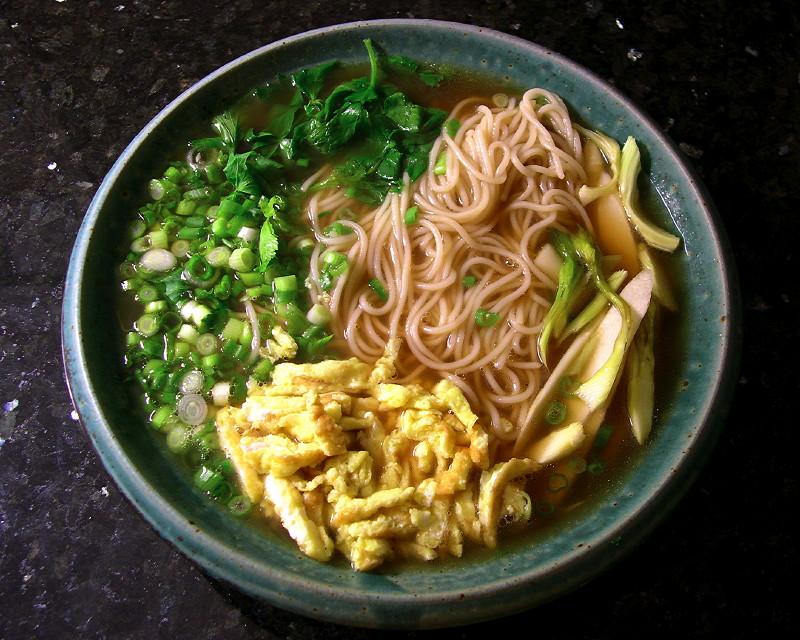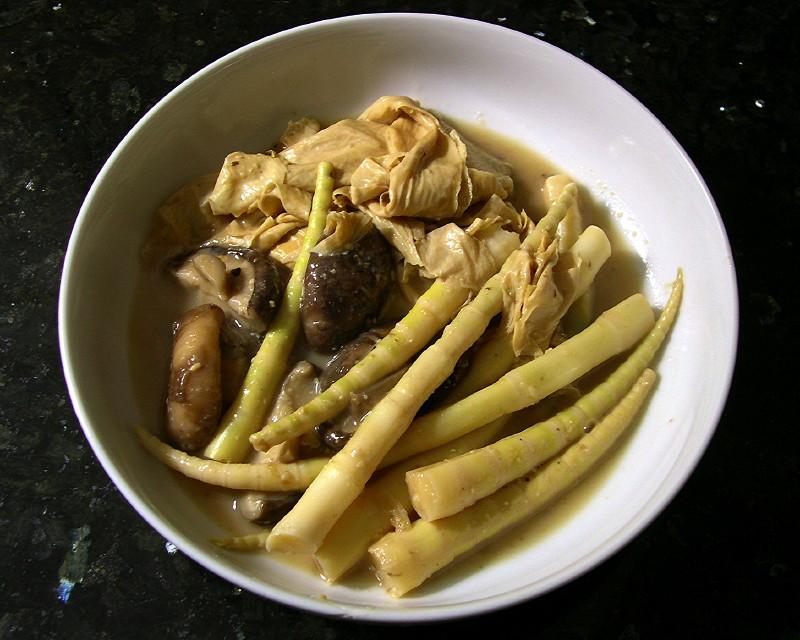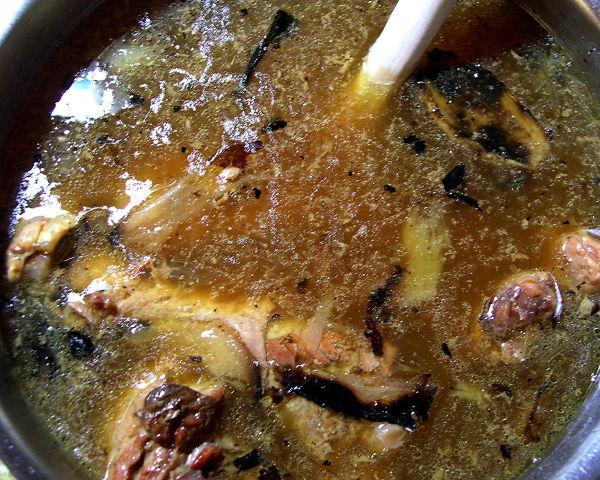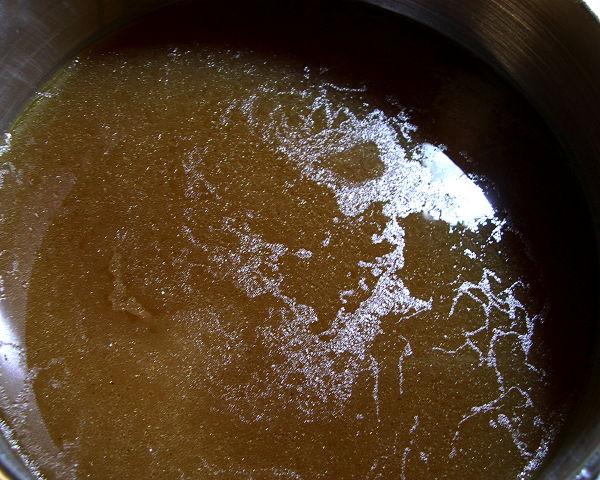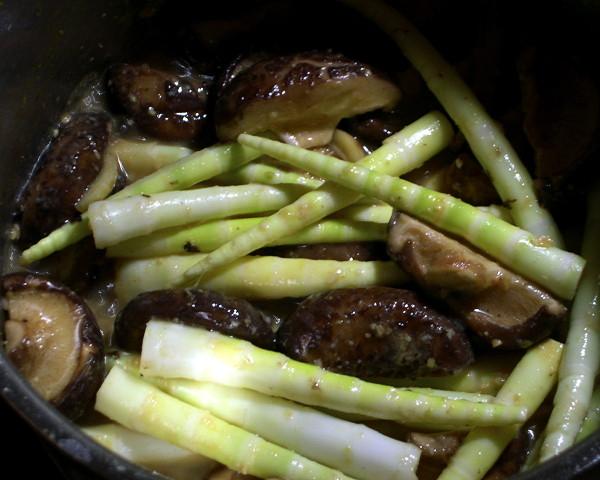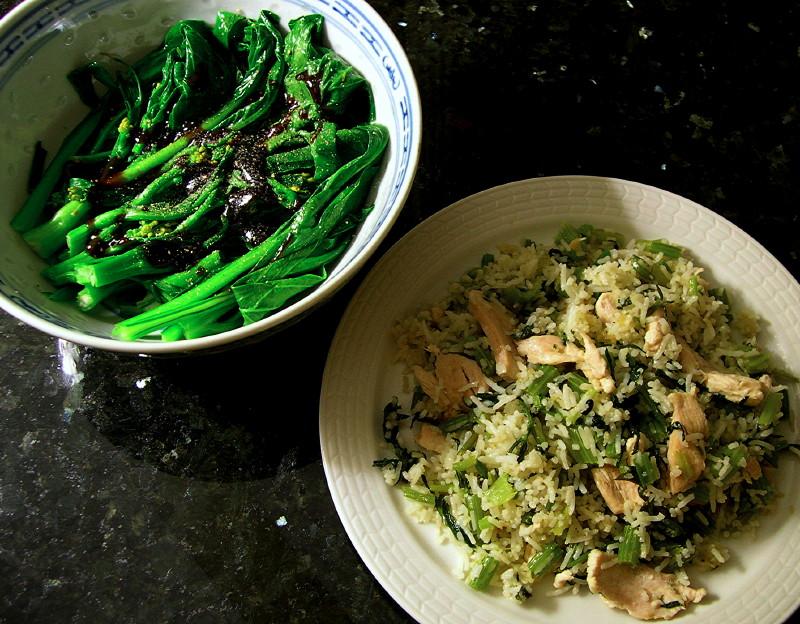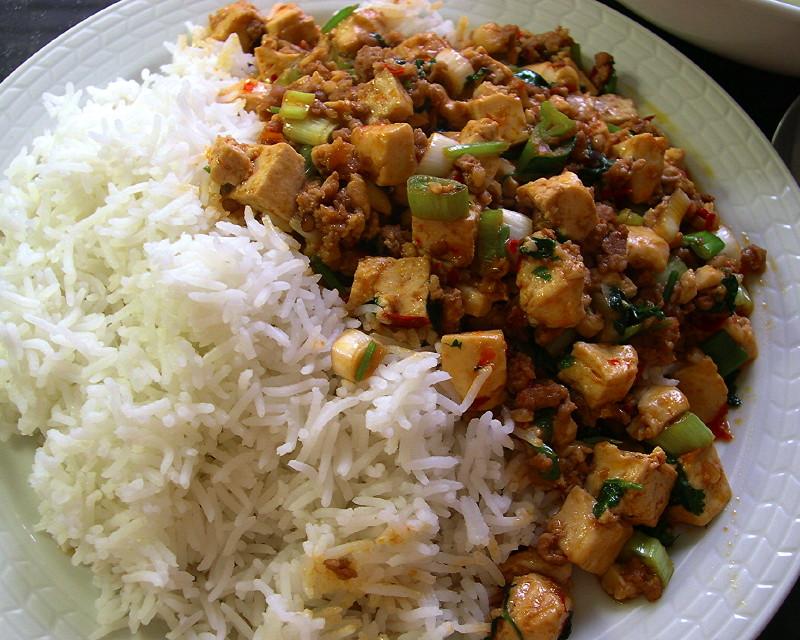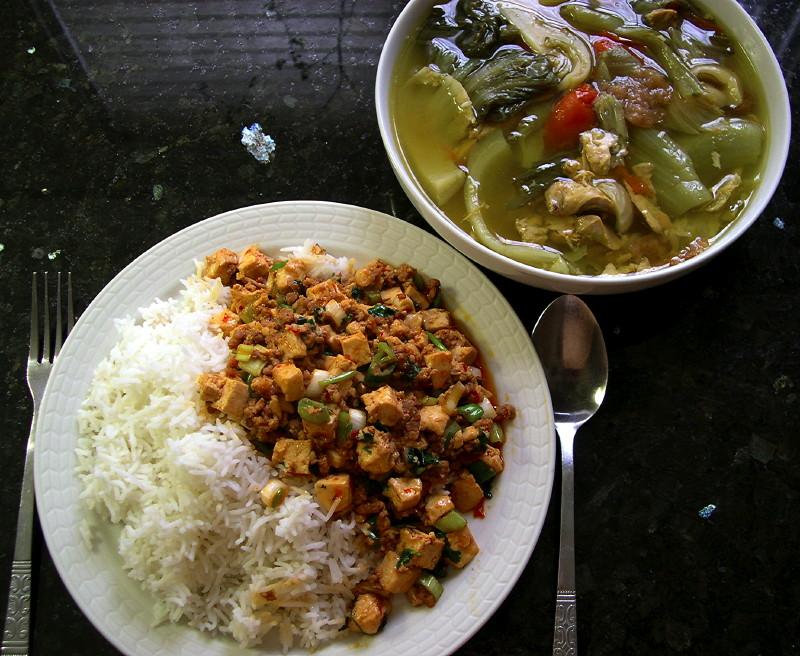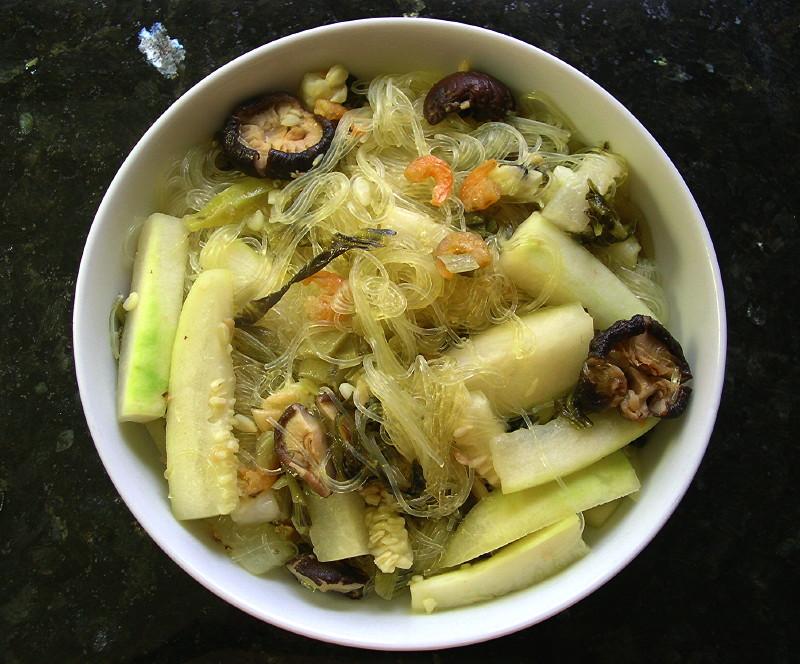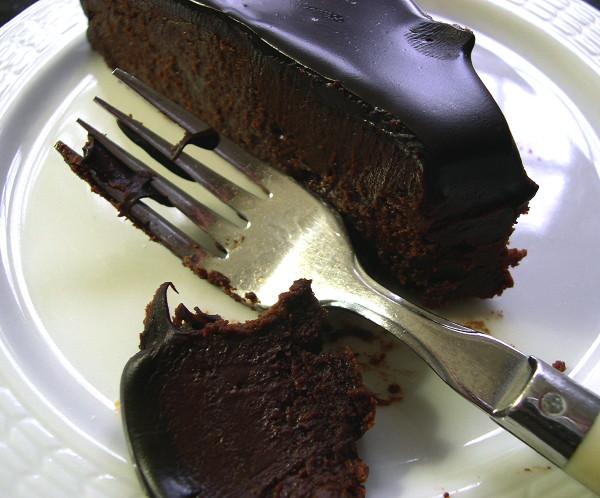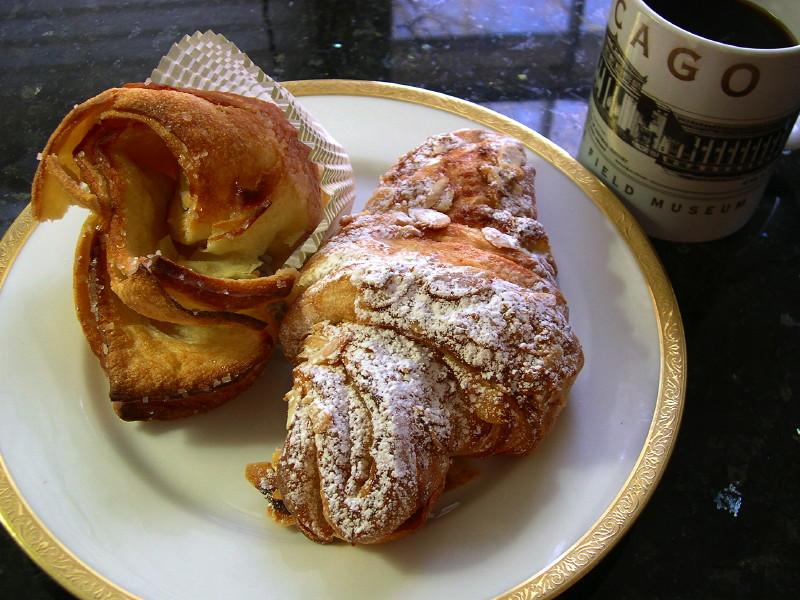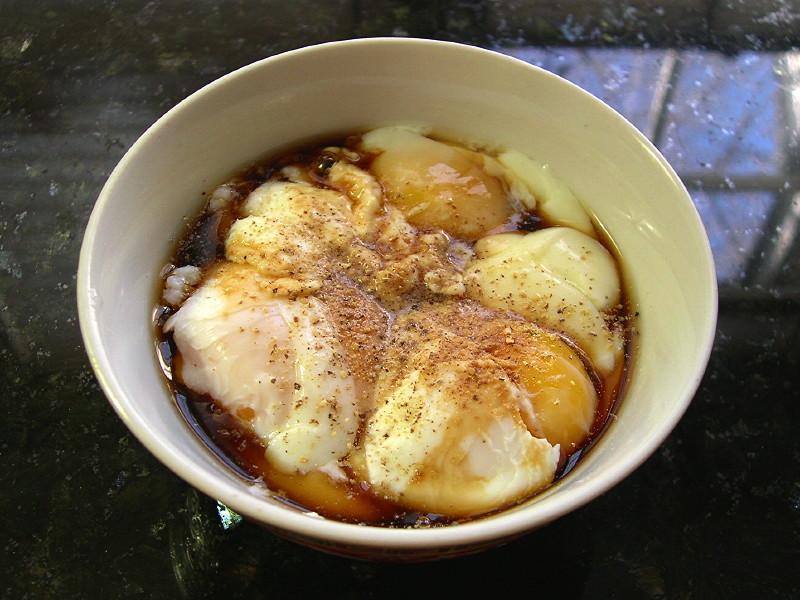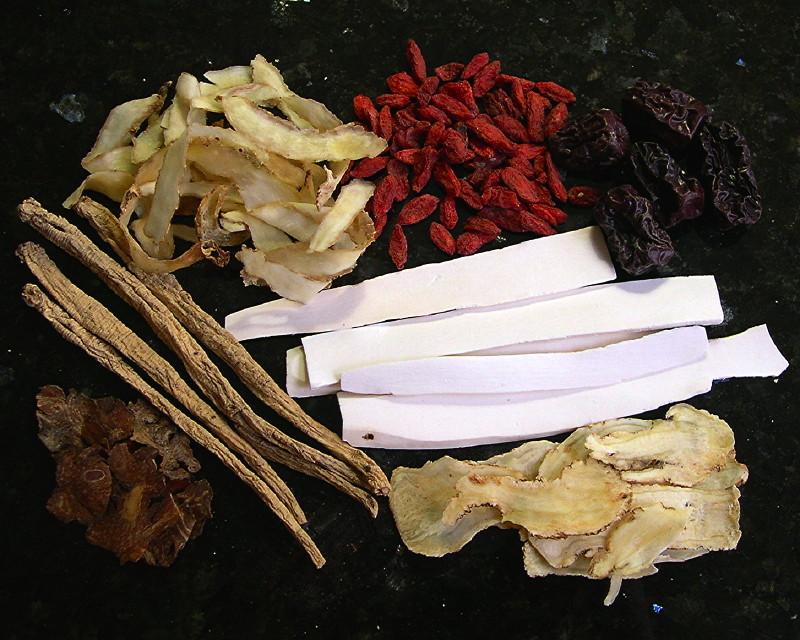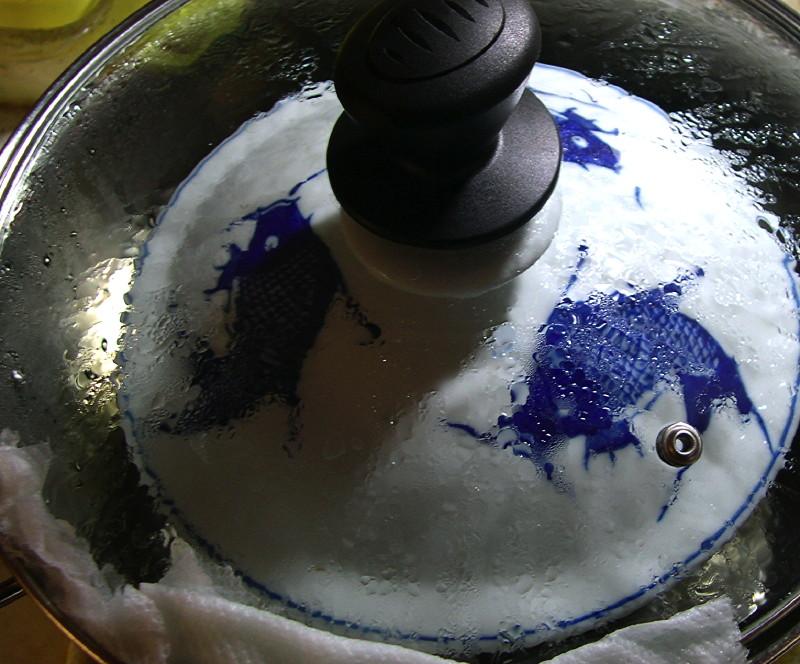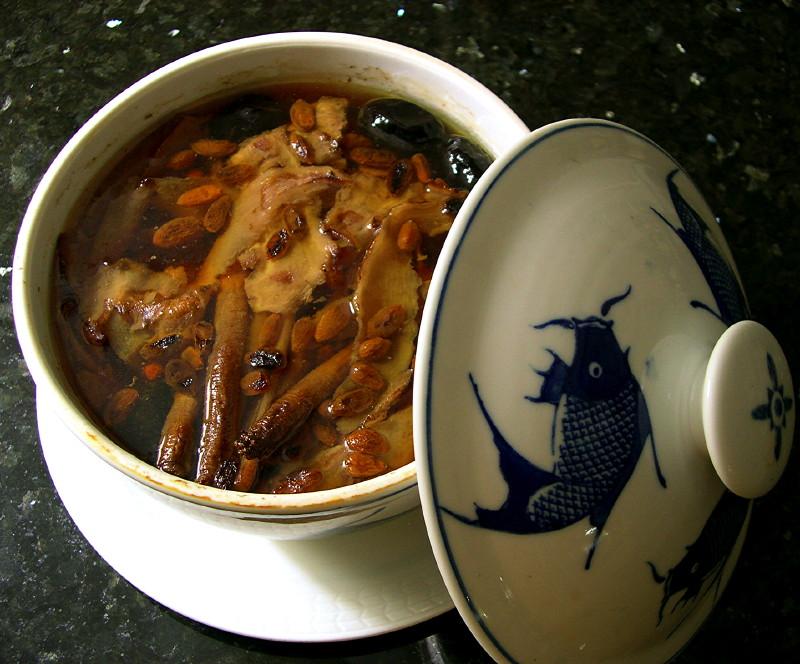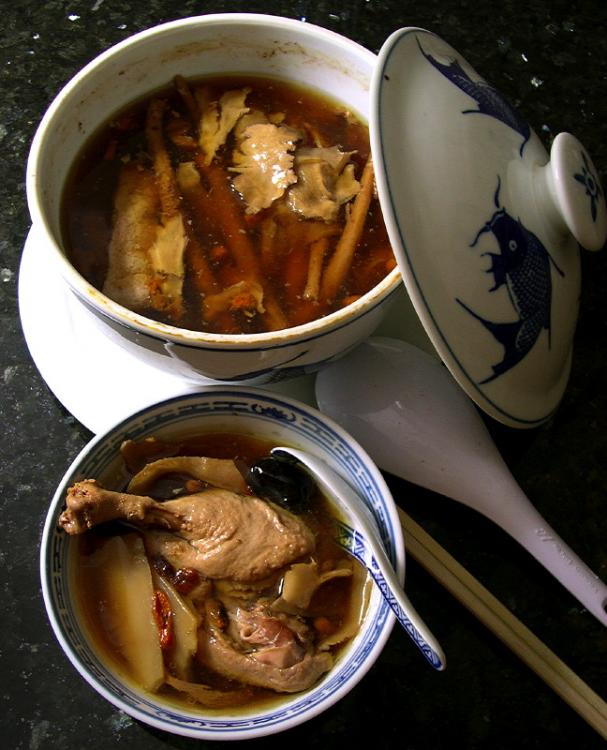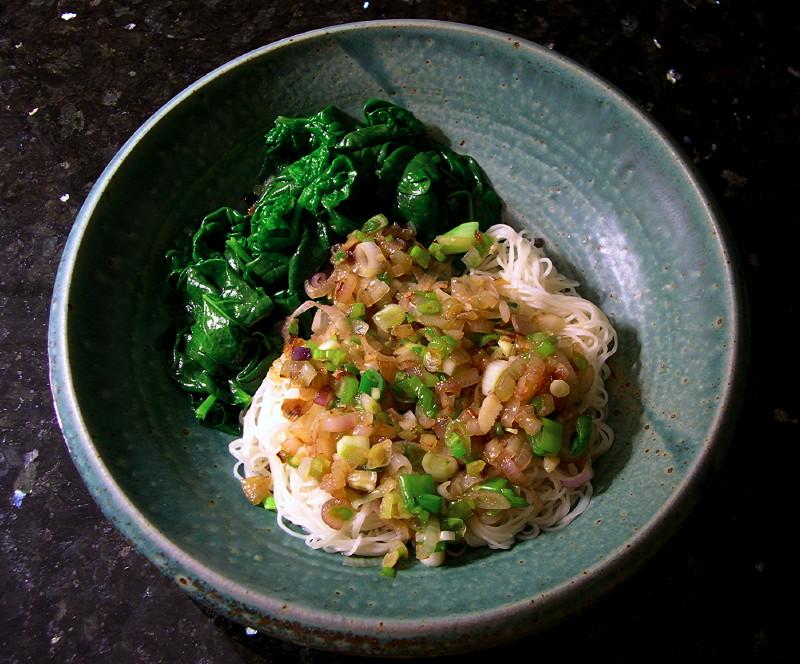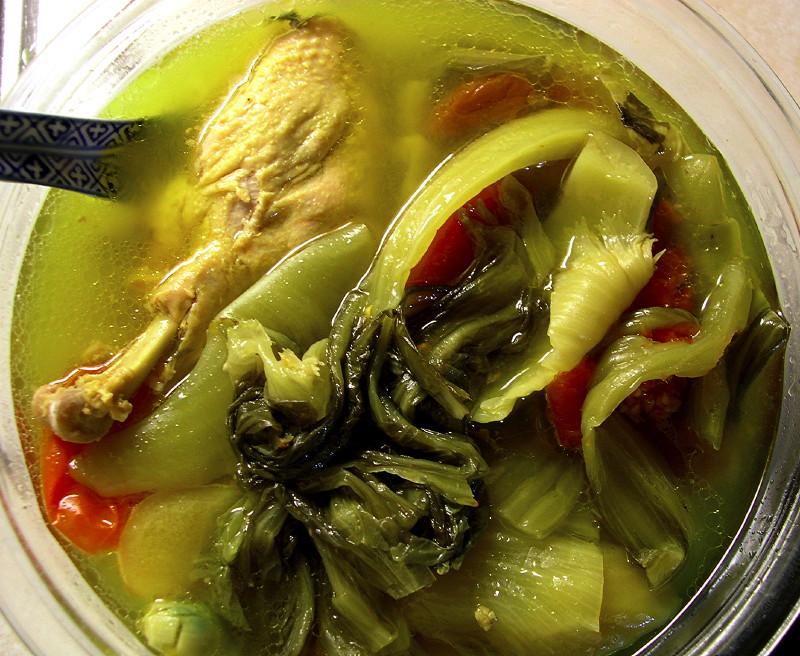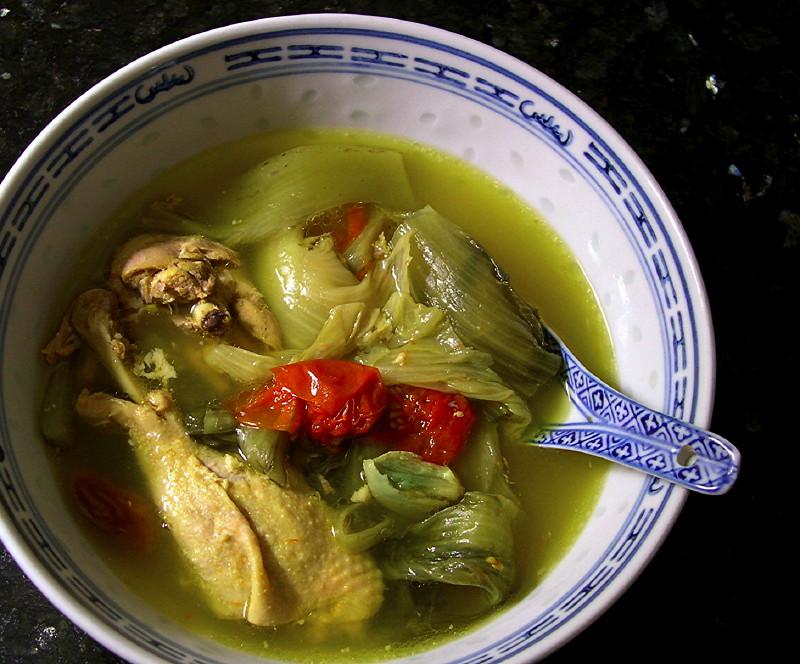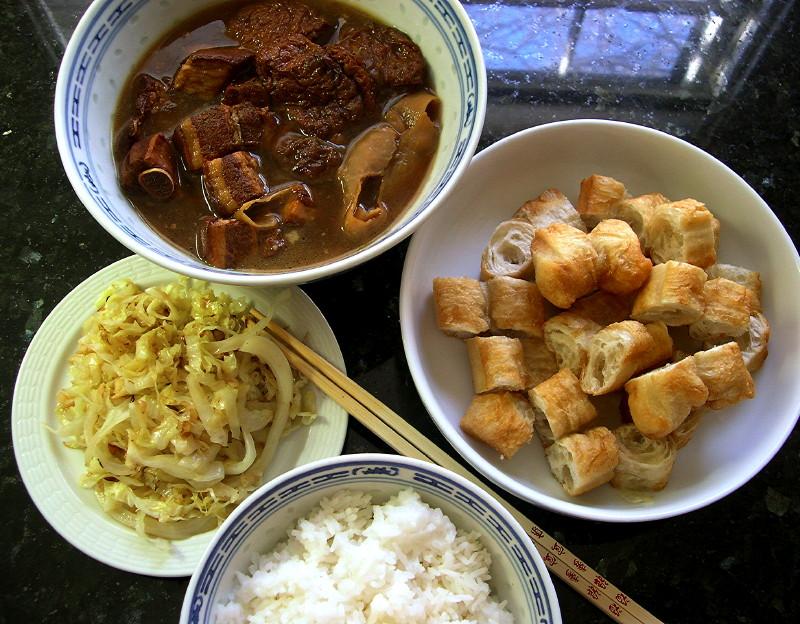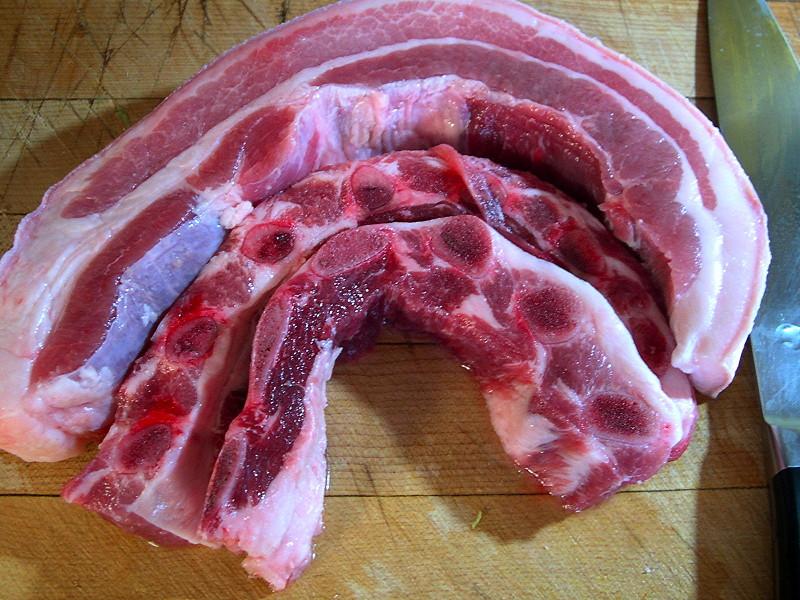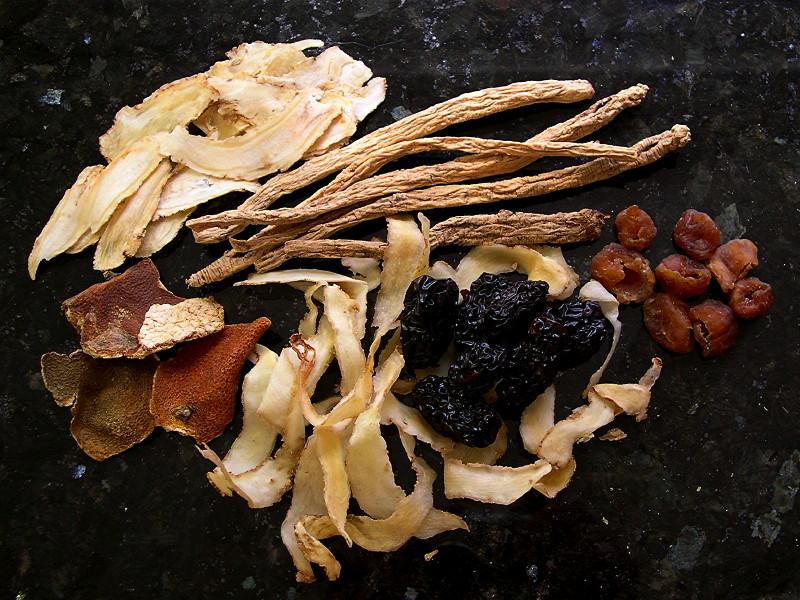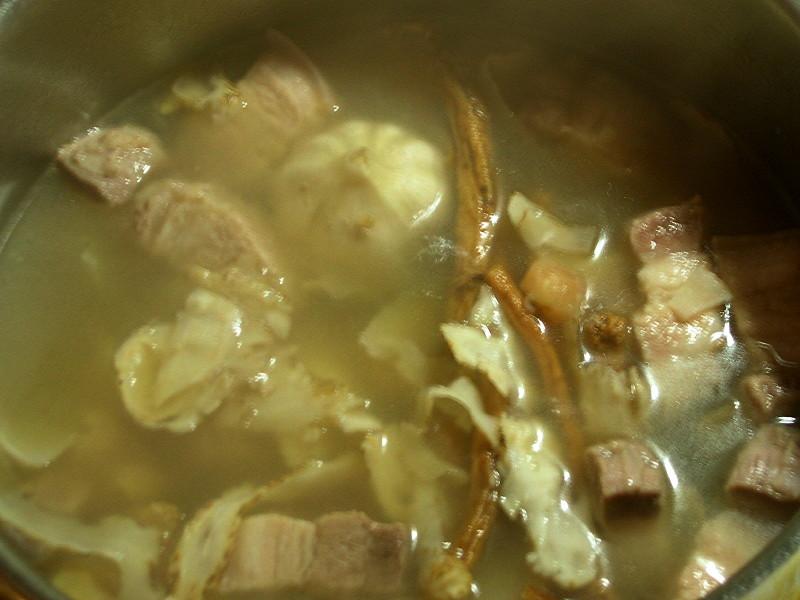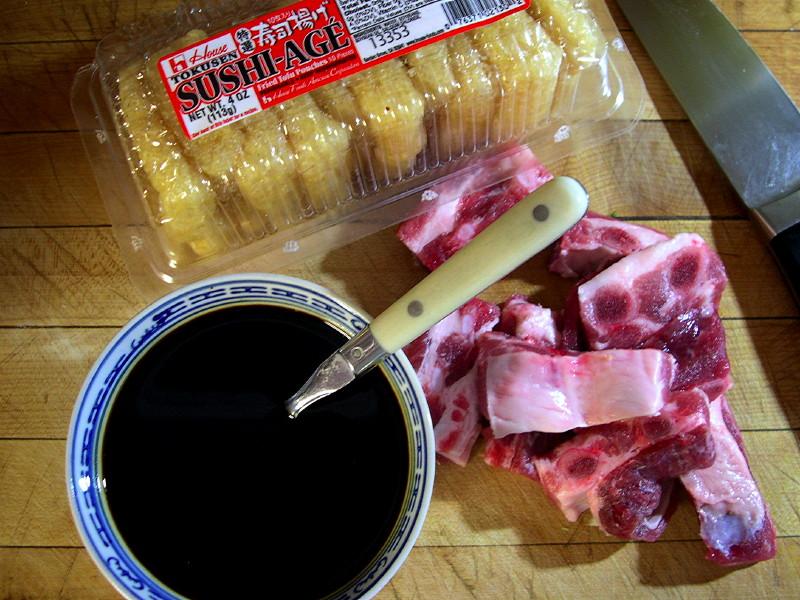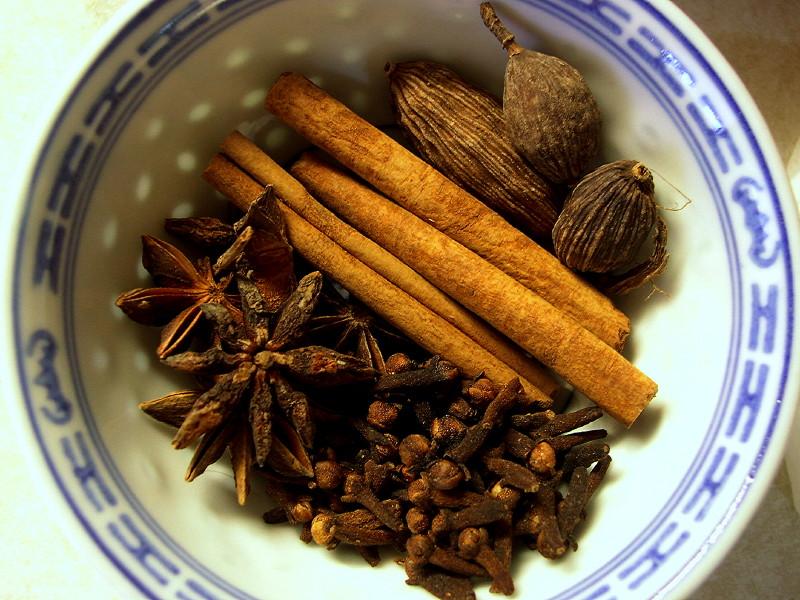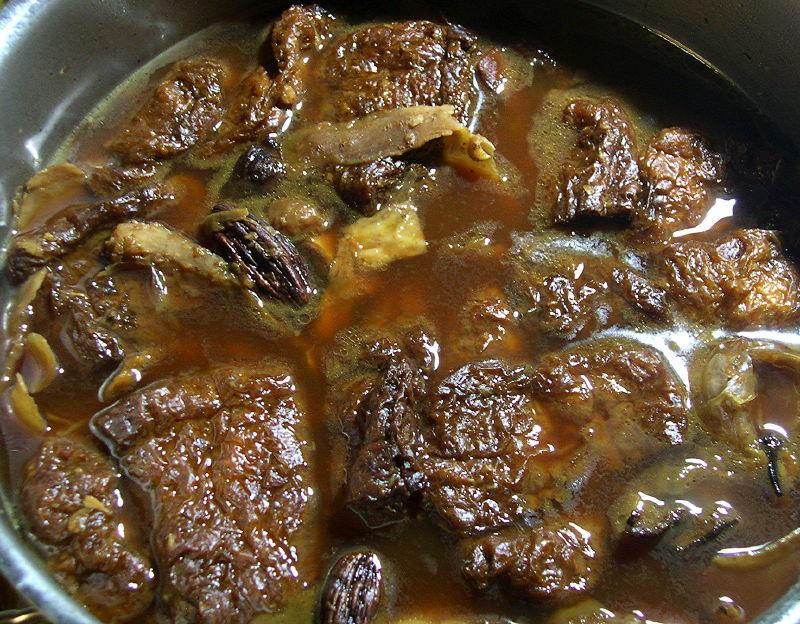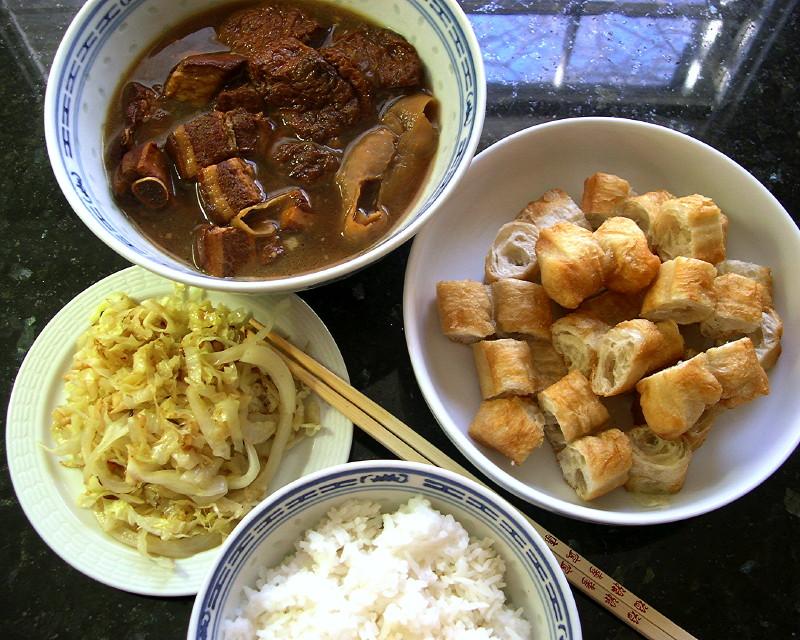-
Posts
3,810 -
Joined
-
Last visited
Content Type
Profiles
Forums
Store
Help Articles
Everything posted by huiray
-
Last night: • Shanghai Yangchun noodles in duck wing stock/soup.§ Dressed with chopped scallions, Chinese celery leaves & the sliced-up heart, raw white asparagus sliced thinly on the bias, plain egg omelette¶ strips. • Fresh Chinese "far koo" (thick-cap "flower-pattern" Chinese mushrooms) stewed with slender bamboo shoots, smashed garlic, mutenka shiro miso and, towards the end, pre-softened partly broken-up sheets of dried tofu sheets. §Meaty fresh duck wings were cut-up, tossed w/ "luscious soy paste", some oil, a few splashes of hon mirin [Takara] then roasted in a hot oven till slightly caramelized. All the wings plus the drippings & caramelized bits etc were transferred to a pot, water to cover added and briskly simmered/lightly boiled with broiled/charred onion slices and ginger slices (ditto) tossed in. Seasoning adjusted to taste, cooked for maybe 3 hours or something like that; left overnight, re-cooked for a short while then filtered through cheesecloth. Yes, loads of gelatin in it. The oil/fat is left in. ¶The flat, bubbly, lightly browned type, with two eggs beaten up w/ some fresh ground white pepper and vegetable oil added in & diluted w/ a little water. Done in a very hot pan w/ plenty of hot vegetable oil, flipped over briefly, broken into chopping-up sized pieces. The stock/soup being prepared: The stewed mushrooms & bamboo shoots in process:
-
Simple dinner last night: • Fried rice - with chopped Chinese celery, peanut oil, sliced chicken breast, sea salt, two-day-old Basmati rice. • Yu Choy Sum blanched in oiled hot water and dressed w/ oyster sauce [Lee Kum Kee] and fresh ground white pepper.
-
For most chicken stocks that would be true, and even for chicken ramen stock. But for pork or beef stock that may not be so. I presume you have seen this thread?
-
Huh, I'm still semi-full from today's breakfast... But here's two recent lunches. ------------------------ • Cubed soft & firm tofu (half-half) sautéed/"stir-fried" with minced pork, finely chopped ginger, chopped smashed garlic, chili-garlic sauce [LKK], yuojialaodouban (友加老豆瓣) (a form of Szechuanese chili bean paste), oyster sauce [LKK], peanut oil, a splash of fish sauce [Red Boat] and lots and lots of chopped scallions and coriander leaves just before the end. • White rice. • Leftover double-boiled pickled mustard & duck soup. (see here) ------------------------- • Peeled Chinese 'hairy gourd'/"chit kua"/"mou kua" sliced into large-ish sticks, sautéed/pan-cooked with lots of chopped smashed garlic in peanut oil, softened dried shrimp ("har mai"), cut-up/sliced soaked & wrung-out pickled mustard ("harm choy"), rehydrated small dried Chinese mushrooms ("tung koo" type), sea salt, a splash of jozo mirin, water, and cellophane/glass noodles (pre-soaked in water) before the end to soak up the liquid and soften further/properly. This is a riff on "tai yee ma kar lui" (大姨媽嫁女). :-) (See here for an example of a straightforward, "clean version" of the dish I've posted about previously on eG). I had seconds. • A chocolate eclair, a raspberry-sugar-coated chocolate truffle, a slice of Bête Noire (flourless chocolate "cake"/torte) from Rene's Bakery. Food coma followed.
-
I like. Of course, for myself I would add in some noodles but then that would be for me. :-)
-
What heidih said. Try: 1) Stewing chickens. 2) Grass-fed/free-range chicken frames¶ (which still have lots of meat on them) from farmers/ markets etc. 3) Silkie chickens (those black-skinned/black-meat chickens) which often have "double-the-chickeny-flavor" of ordinary chickens, unless they are very old (i.e. freezer-aged for eons). 4) Combination of parts, such as those chicken frames + backbones§ + chicken thighs/legs/feet/wingtips. But otherwise, as others have said - chicken legs and thighs, for minimal expenditure. When I am not using run-of-the-mill supermarket chicken for "OK but somewhat blah" stock I probably tend to use stewing chickens (smallish, sort-of scrawny, tough meat) from my local Chinese grocery (when they have it) and get nice fragrant and rich-tasting stock. Otherwise, and when I feel like paying for it, a whole Bell & Evans chicken rather than a Purdue chicken from the local Western supermarket. Also, regarding using just breast meat (no skin, no bones?) - no gelatin to speak of, really. ¶ I sometimes break/cut the backbones open lengthwise to expose the interior, and otherwise mangle-up the bones of the frame(s). More skimming needed, though. § I often don't mind the bits of liver or thymus glands sometimes left on the backbones - they add a bit of "extra flavor". :-)
-
Perhaps you might look at this again: http://forums.egullet.org/topic/147367-if-you-skim-fat-off-soup-is-there-any-fat-left-over-from-emulsion-eg-ramen/#entry1957954 Yes, you can add gelatin from a packet to your pork or chicken stock as a "short-cut" but the result may not have the range of other flavoring components derived from preparing the stock from suitable bones. Remember that boiling the bones gives you that milky (or cloudy, as the case may be) stock with gelatin. Simmering gives you that (largely) clear stock with gelatin. In both cases with the use of bones with sufficient connective tissue and collagen. Bones without any collagen will not give you a stock with appreciable (if any) gelatin.
-
A couple of croissants this morning [from Rene's Bakery] plus three soft-boiled eggs w/ light soy sauce & white pepper. The croissant on the left was described by the guy at the shop as "coming out a bit funny" but it cried out to me "Take meee hoooome..."
-
No, not really, sorry...I do this stuff often in a wing-it way. :-)
-
Double-boiled (steamed) Herbal Duck Soup. Two duck legs, cut-up, skin-on, fat retained. Herbs & stuff, some Himalayan salt, some hon mirin [Takara], some Shaohsing wine, water. All in a heavy porcelain “steamer bowl” with heavy lid. The herbs & stuff: Top row: "Yook Chook" (玉竹; Yale: yuk6 juk1; Polygonatum odoratum (Mill.) Druce), “Kei Chee” (杞子; Yale: gei2 ji2; dried wolfberries/goji berries), “Hung Chou” (紅棗; Yale: hung4 jou2; Ziziphus jujuba). Middle row: “Tong Sam” (黨參; Yale: dong2 sam1; Codonopsis pilosula Nannf), “Wai San” (淮山; Yale: waai4 saan1; Dioscorea opposita). Lower left: “Chueen Kung Peen” (川芎片; Yale: chyun1 gung1 pin3; Ligusticum wallichii; syn. Ligusticum chuanxiong, “Szechuan lovage (root)”) Lower right: "Tong Kwai" (當歸; Yale: dong1 gwai1; "Radix Angelica Sinensis"; Angelica sinensis). Being steamed (8 hours): Finished soup in steaming bowl: Some of it in a serving bowl. Some of the yam slices (the Dioscorea), Solomon’s Seal rhizome (the Polygonatum), a red date or two, and Goji berries were also scooped out to eat.
-
Glad the stock seems to be working for you! Regarding the fat content - as i mentioned before, I really don't know how much fat is in the milky stock, but I myself would assume that there is likely to be some. I doubt it would be "half fat", although I might be surprised if someone does an actual chemical analysis of it. :-) Why not "go for it" and have a nice bowl of ramen with that fat added back in as you propose to do and the hell with it? (You may exercise tomorrow) After all, I suspect one would not be eating this for every meal for days on end. :-)
-
Regarding the "meifun" dish: "meifun" means "rice noodle", actually. "Singapore Meifun" which is a common dish in Chinese/Asian take-outs in the USA (and Canada?) - that yellowish dish, often containing curry powder as you noted - is a dish that does not exist in Singapore. :-) The "Shrimp Meifun" is self-explanatory. The "House Meifun" is simply what the place/chef tosses together, a bit of everything, although they have a sort of "standard formula" which is similar across many places as you have found - that is at least partly because many take-out places and smaller/mall-type/non-descript places are run by Fujianese, all using the same menu, most setting up shop after travelling through the same network stretching from a few villages back in Fujian through one of the Chinatowns - traditionally that was NYC . That "extra taste" you describe might simply be lots of MSG? Or a shrimp/pork stock which they may use - The Hokkiens/Fujianese are one of the folks who use that combination (shrimp+pork) to make stock, something not common in other dialect groups like the Cantonese. But perhaps an eGulleteer whose family etc may have run one of these places might step forwards here and let us know. Have you actually tried adding in Chinese oyster sauce into your sauce/stock mix when you whipped up your home versions of these "meifun" dishes? One does not need much. That may be another possibility for what you are missing, even though it may have some actual (fermented) soy content. I still suspect that you may be simply "tasting" lots of MSG, unless the places you patronize loudly trumpet "MSG-free" status...which usually means that they don't actually spoon in the crystalline stuff, but glutamate or inosinate content would still be found in the sauces/stocks they use including that "hydrolyzed soy". (I would think that they do use some stock/sauce to make that "House Meifun" you like - it just gets absorbed into the meifun and the whole mixture is cooked down to "dryness", which is the appropriate way, as distinct from meifun dishes like some Cantonese-style meifun dishes where the meifun is pan-fried to give a crispy layer then plated with a sauce with vegetables and protein in it poured over the crispy meifun) They would NOT be using this, because of the expense, but try getting some XO sauce online for your experiments in making "meifun" at home - this is a quite tasty sauce, frequently reserved behind the cashier's counter even in Chinese stores. :-) Have a look at this image set: 炒米粉 . Try visiting the pages for what looks attractive to you and use the google translator for interesting ones? (Try this one as a teaser) p.s. Try splashing in some Shaohsing wine too. :-)
-
FeChef, what sort of soy sauces have you been getting from the stores? (Actual brand names) Other than these "take-out" packages, that is. I must say (in tandem with Liuzhou) that these soy sauce packages may not actually contain soy sauce (I don't know for sure). Could it be that they simply have some sort of hydrolyzed stuff concocted to have a taste reminiscent of actual soy sauce? I myself have never used these "soy sauce" packages when I did get them (on the rare occasions) with some take-out from some "Chinese" place or other (I'd just throw them out) so I can't even say what they really taste like... But in your case it might be the best avenue for you to pursue Lisa Shock's suggestion to get what you like, in a quantity larger than a few packages.** ** In this context I once found myself in a situation where I asked a local Chinese "take out" shop for a couple of those fried wonton-skin crispy bits that they would hand out with regular orders. I was charged 50 cents for each package of those fried strips, which I thought was utter usury, but I was in a situation where I needed them immediately for a particular dish.
-
Uh, say what? An "Asian" dish (in your case I gather you mean "Chinese") requires soy sauce???? Um, NO. I don't know what sort of things you have been cooking but I would say to you that what makes a dish "Chinese" does not require the use of soy sauce.
-
That's interesting, gfweb. Sounds quite delicious. Could you spare a bit more detail? Pork - minced pork? Any particular kind? What seasonings, if any? Basil pesto = "regular"/standard-type pesto (w/ cheese in it already)(what kind?) ? Blush sauce - could you say a little more?
-
Oops. I forgot that pickled plums also went into this version of the soup. (Ripped-apart flesh plus the stone as well) In a sense this can be considered as aTeochew-style soup, for those interested in details.
-
Yes. It's from a local artisan. Made in her pottery kiln.
-
Glad they (Noodles & Co) made the move to get rid of tipping. Nevertheless, I hope you have better food than I have had on my visits to the local franchisees in my area. I tried a few different places in the hope that the 1st time was a fluke, to see if they deserved another chance etc (at least for my taste) and I had to conclude that for me, personally, they served some of the most regrettable (and confusion**-type) food around. But others may have had good experiences. ** versus 'fusion'. ------------ I have not studied the entire thread carefully and a search for "Next" did not turn up what I was looking for - so, I might comment that various restaurants, usually higher-end ones, have moved to the "ticket" system. No doubt most of the folks on eG know about this quite well? If so and it has been discussed then my apologies. For those who do not know of this, Next Restaurant (and after that, places like Alinea and a few others, I think) in Chicago instituted a prepaid ticket system with online-only transactions whereby the entire cost of the meal (food, drinks, all applicable taxes, mandatory "service charge") is prepaid by the intending diner for a meal at a certain time on a certain day. When you come to the restaurant you eat your meal then get up and go. No further money or financial transactions cross the table and no "tipping" is done at the end of the meal. It's like buying a ticket to a concert or a show. It is non-refundable, and if you don't show up you lose your money. You are free to sell it (in the approved manner) to someone else, of course, or to give it to someone else to use with "transfer of ownership" notification to the restaurant. In recent times other restaurants are adopting this system too, with mixed receptions from the dining public.
-
Yes, that looks substantial enough. :-) Not much carb - but I seem to remember that you are on a low-carb diet, is that correct?
-
Last night: • Min Sin (mee sua) [this one] tossed w/ a sauce of {chopped shallots and scallions sautéed in peanut oil and with some fish sauce [Red Boat] & ryori-shu [Morita]}. Accompanied by fresh baby spinach blanched in oiled hot water. • Pickled (salty & sour) mustard & duck leg soup. This version was steamed (i.e. "double-boiled soup"; Cantonese-type "燉湯") for about 3 hours. With Campari tomatoes, sliced ginger, smashed garlic cloves, a bit of salt, a few dashes each of (hon) mirin [Takara] and rice vinegar [Kong Yen aged premium].¶¶ No additional oil added, the duck fat was used to provide the oil in the dish. ¶¶ ETA: ...and a decent amount of cracked white peppercorns. Soup just out from the steaming pot: A portion, bowled.
-
http//:chowhound.chow.com:topics:803466
-
One dunks them in the soup to "gather up" some of the soup then pop them into one's mouth before they become soggy so they still have some crunch. :-) Or chomp on them as-is. I do both, so do most people, I think. Most folks would want them crisp/warm on the plate; cold and limp counts as a strike against the vendor/shop/food stall if eating out.
-
Today: • Pork belly & short-cut pork spare ribs herbal-type Bak Kut Teh. • Stir-fried green cabbage. • Chinese crullers, cut-up. • White rice. See this post in the pork belly cook-off for more details.
-
Pork Belly Bak Kut Teh. Bak Kut Teh (肉骨茶), literally "Pork¶ Bone Tea" (in the Hokkien dialect), is a widely-eaten dish in certain parts of Malaysia and Singapore, with lesser consumption in other areas of Malaysia and SE Asia. Every vendor of BKT will have available, at a minimum, pork spare ribs or meaty pork ribs as meat choices. The other "meats" that will be widely available include pork belly, pig trotters, pork hocks, pig intestines (large & small), etc. There are different "styles" of BKT and the Wiki article discusses the broad categories of them; while individual vendors will, aside from the meat(s) selections, may have their "own" idiosyncratic versions and/or hot-pot versions and/or the inclusion of stuff like enoki mushrooms or other mushrooms, Napa cabbage ("wong nga pak"), etc etc. The rice that is served also may vary from rice cooked in stock w fried shallots and garlic to simple plain white rice, and one or the other kind may be hated or loved by one or another aficionado of BKT. Chinese crullers (油炸鬼; yau4 ja3 gwai2 (Yale) in Cantonese) are also a common accompaniment for BKT, and some folks shun rice in favor of a plate or two of crullers alone. ¶In Chinese the character "肉" actually means, simply, "meat". However, in the absence of any modifiers or qualifiers the default meaning when talking about Chinese (and Chinese-type) cuisine is pork, unless the context indicates something else. (beef would be called "牛肉"; mutton/lamb would be called "羊肉" - as examples) See the Google image set embedded in "肉骨茶" above for examples of this dish. One will see different combinations of cuts of meat, including pork belly slices of course; in soups of varying darkness and with varying accompaniments. :-) I've not infrequently made BKT with pork spare ribs and meaty ribs before. This time, I made BKT with pork belly and short-cut pork spare ribs; using a selection of herbs in a variation of the Canto-Hoklo style. The pork belly strip and the ribs: These were cut-up into chunks. The pork belly went into water with two whole heads of garlic and brought towards a simmer. A selection of herbs were added in, the mixture brought to a boil, then lowered to a brisk simmer. A little sea salt was added. Minimal skimming was needed. Samples of the herbs and other stuff that went in. (Somewhat more of the dried roots/shaved rhizomes than shown actually went in) Starting from top left and going clockwise: Angelica sinensis, Codonopsis pilosula Nannf., dried longan meat, Polygonatum odoratum, dried tangerine peel; and sitting on the P. odoratum is a particular sort-of smoked variety (called "lam jou") of big select dates of Ziziphus jujuba. See here for additional info about these herbs &etc. Pic of the pot w/ stuff (somewhat blurry, sorry) after the herbs &etc went in: After simmering (covered) for maybe ½ an hour the pork rib(lets) went in and the mixture simmered maybe 20 min to ½ an hour more. The spices (see below) then went in, followed by the sauce mixture (dark soy sauce [Yuet Heung Yuen], light soy sauce [Kikkoman], oyster sauce [Lee Kum Kee]) and the mixture simmered (covered for a while more (maybe ½ an hour to 40-45 minutes more. Abura-age (I used "sushi-age" pouches) each piece cut in half went in towards the end. The pork ribs, sauce mix, abura-age: The spices: cloves, star anise pods, cinnamon sticks, black cardamom (草果): The completed BKT after resting: Eaten with cut-up Chinese crullers (reheated/recrisped in the oven), simple stir-fried green cabbage w/ garlic & salt, white rice (Hom Mali).
-
That's because those folks cannot conceive of a dish resembling a fried Wiener Schnitzel being covered in anything other than a white gravy. But she will have to speak to this herself. "Country Fried Steak" is really the same thing, only with a different gravy, in a generalized sense. Ditto mushroom gravies. If you insist on CFS being served with a white gravy only then one knows where this person is coming from, and it does not allow of any variation from Gospel Truth. ETA: It seems to me that your response is entirely appropriate to those who fiercely defend the notions of a particular foodstuff regardless of whether said foodstuff is suitably located in such-and-such a location. Fare thee well.



